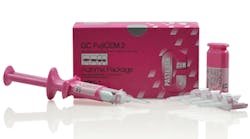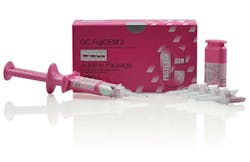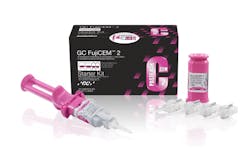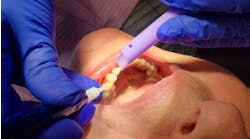Randy Weiner, DMD, presents research on resin-modified glass ionomer cements and reviews GC FujiCem 2 from GC America.
A confusing part of restorative dentistry revolves around which material to use. When it comes to indirect restorations, there is no consensus as to which cement to is the most ideal. In 2005, I conduced a survey of dental schools in the United States and Canada to determine what these schools were teaching about what types of cement should be used in specific situations. I concluded that there was no agreement among the schools as to which material was appropriate for any given clinical scenario. (1) We have many products to choose from, and their numbers keep increasing as manufacturers continue to introduce new cements and improve existing ones.
An article published in the Australian Dental Journal stated that an indirect restoration must be sealed with a luting agent, the primary function of which is to fill the minute void between the tooth preparation and restoration and to mechanically lock the restoration in place to prevent dislodgement during function. (2)
Ideal properties of a dental cement include biocompatibility; caries inhibition; reduction of microleakage; physical properties that resist functional forces; insolubility; absence of postoperative sensitivity; low film thickness; extended working and setting time; ease of dispensation, mixing, cleanup, and use in general; stable bonding to the remaining tooth structure and the restorative material; radiopacity; and color stability. (3,4)
This article will review the resin-modified glass ionomer cement GC FujiCem2 from GC America.
Background: Resin-modified glass ionomer cements
Jivraj, et al., state that the resin-modified glass ionomer cement is the most frequently used cement for the cementation of well-fitting porcelain-fused-to-metal (PFM) crowns, full-cast crowns, and high-strength ceramic restorations (e.g., zirconia or aluminum core). (5) Christensen suggests that a resin-modified glass ionomer cement is the cement of choice for routine cementation of PFM and zirconia-based restorations because of its desirable characteristics. (6) He also writes that long-term studies have shown the use of a resin-modified glass ionomer cement to be sufficiently retentive for adequate tooth preparations, specifically with respect to lithium disilicate restorations. (7) A 2004 survey indicated that more than half of all porcelain-fused-to-metal crowns were cemented using a resin-modified glass ionomer cement. (8)
Glass ionomer was developed in the early 1970s. The first of the two components is an acid-soluble calcium fluoroaluminosilicate glass, and the second is an aqueous solution of polyacrylic acid. When both components are mixed, an acid-base reaction occurs. The acid etches the surface of the glass particles, resulting in the release of calcium, aluminum, sodium, and fluoride. (9) The overall pulpal biocompatibility of glass ionomer materials has been attributed to the weak nature of the polyacrylic acid, which is unable to diffuse through the dentin due to its high molecular weight. (10)
An advantage of glass ionomers is their ability to bond with teeth. This adhesion occurs via a hydrogen bond between the carboxyl groups of the polyacrylic acid and the calcium in the tooth. Additionally, these materials have a low coefficient of thermal expansion, similar to tooth structure, which allows them to maintain a bond to tooth structure and allows for the release of fluoride to the surrounding tooth. The benefit of a low coefficient of thermal expansion is the reduction of microleakage and postoperative sensitivity. (11) The fluoride release occurs early and tapers after approximately 10 days. (7)
Fluoride release from these products causes the formation of fluorohydroxyapatite in the adjacent tooth structure, thereby making it more resistant to demineralization. (12) The fluoride release inhibits secondary caries, and fluoride is toxic to those microorganisms associated with caries. (13,14)
The fluoride that leaches out can be replaced or recharged with a neutral fluoride because an acidic one would dissolve the surface of the glass ionomer. (15) There are several vehicles that can accomplish this: toothpaste, topical fluoride application, and gels. The fluoride gel is the most effective. (16) Fluoride release from restorative materials can reduce caries, with no patient compliance required, and it's important for controlling caries in high-caries-risk patients. (17)
Resin-modified glass ionomer cements were developed to overcome the high solubility of glass ionomers. These cements bond to the inorganic dentin via a link to the calcium ion in the dentin. As with glass ionomers, this is an acid-base reaction that occurs in an aqueous environment. By combining the advantages of glass ionomer and resin, these materials also release fluoride, have an increased resistance to microleakage, adhere to tooth structure, and are less soluble than a conventional glass ionomer. (18,19) These materials have a longer working time than traditional glass ionomers. (9) Clinicians should be aware that, after the photopolymerization of the resin-modified glass ionomer is complete, the glass ionomer setting reaction continues.
The fact that the polymerization occurs prior to completion of the acid-base reaction helps decrease the solubility of these products. This makes this material more advantageous in a moist environment. Resin-modified glass ionomer cements are good for usage with restorations that have margins where crevicular fluids, salivary flow, or tongue control can present clinical challenges to the dentist in maintaining a dry field. (20)
Resin-modified glass ionomers have a chemical bond to sclerotic dentin than is stronger than the bond that results from etching dentin and placing a dentin bonding agent. (21) This is beneficial in scenarios when sclerotic dentin has been exposed because an existing restoration has been removed in preparation for an indirect restoration.
Ideally, when a preparation is made for a cast restoration, all caries would be removed. There is, however, the possibility that some caries-affected dentin will remain. Clinicians should be aware that the bond strength of a resin-modified glass ionomer cement to caries-affected dentin is higher than the bond strength of a glass ionomer to caries-affected dentin. (22)
Metal posts cemented with a resin-modified glass ionomer cement may be difficult to remove, should it be necessary to reenter the root canal system. (23) When mechanical retention is compromised, a resin-modified glass ionomer cement should be used. (23)
Some clinicians may apply a cavity disinfectant to the completed preparation. A 2009 study showed that the application of 2% chlorhexidine gluconate did not interfere with the microtensile strength of glass ionomer materials to both sound and caries-affected dentin. (24) Additionally, it was recently reported that the application of glutaraldehyde/ 2-hydroxyethylmethacrylate (HEMA) desensitizers to the preparation does not interfere with the use of a resin-modified glass ionomer as the final cementing agent. (7)
Because both glass ionomer and resin-modified glass ionomer products are water-based, clinicians should be aware of the expiration dates of the products in use. Although a product may appear clinically usable after its expiration date, its viscosity may be altered and its strength reduced.
Previously, low film thickness was mentioned as a characteristic of an ideal cement. Resin-modified glass ionomer cements are known for their low film thickness. The advantage this offers is that less material can be placed inside the casting, which can help eliminate the hydraulic issues associated with replacement of the prosthesis. (20) This can also reduce the chance of the casting not being fully seated.
Glass ionomer and resin-modified glass ionomers are available in powder-liquid, paste-paste, and encapsulated formulas. The powder-liquid versions are usually less expensive. Clinicians will find that the paste-paste products will produce equal and consistent amounts of both components (based on manufacturer research). These delivery systems also allow for easier cleanup, as do the encapsulated products that do not require hand mixing. Dentists who use a syringe delivery system that includes an automix tip will find that it is fast, easy to use, and convenient, and that it reduces the amount of air in the final mix compared to hand mixing. (25)
GC FujiCem2 is such a product. GC FujiCem has been available for many years and has enjoyed much success. The manufacturer, GC America, declares that over 150 million crowns have been cemented since the cement was introduced in 2001. In July 2012, an improved version of this material was introduced. GC FujiCem2, a resin-modified glass ionomer cement, is a paste-paste material (figure 1).
Clinical relevance of GC FujiCem 2
Internal research from GC America found that GC FujiCem 2 had more fluoride release after one week than other resin-modified glass ionomer cements. As with other resin-modified glass ionomer cements, the released fluoride can be replaced.
Using a resin-modified glass ionomer cement with a low film thickness would allow the casting to be properly seated. As previously stated, this characteristic would reduce hydraulic forces involved with cementation of castings. The film thickness of 10 microns is less than that of other, similar products, including GC FujiCem, so seating of castings should be easier for the clinician.
A stronger cement can improve the retention of indirect restorations. This second generation resin-modified glass ionomer has increased bond, flexural, and compressive strengths. This is due to, what has been termed, F2 Flex Fuse Technology, which incorporates high-elastic crosslinking monomers with a modified filler-surface treatment.
The flex is due to a flexible long-chain monomer that gives the material its higher flexural strength by acting like a shock absorber to resist occlusal forces, making the material suitable for all-porcelain restorations in addition to metallic-based ones. The modified filler-surface treatment creates a strong bond between the glass particles and the resin. A stronger material also translates to a reduction in the likelihood of restoration dislodgement. Clinicians should remember that glass ionomers have a chemical bond to tooth structure. On the topic of long-term proven results, according to Clinicians Report, FujiCem2 is an ideal product for use with zirconia, lithium disilicate, and metal-based crowns. (26)
There are benefits that some products have that do not directly affect the patient. One such benefit is the ease with which a product can be handled by the clinical staff. The clinician's ability to dispense and mix the material with minimal effort aids the patient indirectly because it can result in a shorter visit. GC FujiCem 2 is one of those products. It is available in an intro Kit, automix package, and a refill kit. Those dentists who mix by hand should be aware that pastes A and B have different colors; spatulation is complete when the material is homogeneous in color (light yellow). The material reaches a rubbery consistency one minute after restoration placement, allowing for a quick and easy removal of the excess material.
GC America has designed the Paste Pak system to dispense the correct amount of each paste so that the clinician has right proportions of each material.
There are two delivery systems for clinicians to choose from: the GC FujiCem 2 dispenser and the Paste Pak dispenser. The GC FujiCem 2 dispenser is 85% lighter than the metallic Paste Pak instrument. Both dispensers can be steam autoclaved, and both systems allow the operator to dispense directly into the casting (or tooth, in the case of a post-and-core restoration) via the automix tip or onto a mixing pad for hand spatulation.
Editor's Note: This article first appeared in Pearls for Your Practice: The Product Navigator. Click here to subscribe. Click here to submit a products article for consideration.
References
1. Weiner R. Teaching the use of liners, bases, and cements: A 10-year follow-up survey of North American dental schools. Dentistry Today. 2006;25:74–79.
2. Hill EE and Lott J. A clinically focused discussion of luting materials. Aust Dent Journ. 2011;56(1 Suppl):67–76.
3. Strassler HE, Coviello V. FujiCem resin-reinforced glass ionomer cement. Contemp Esthet Restorat Practice. 2001;12:1–2.
4. Simon J, Darnell L. Considerations for Proper Selection of Dental Cements. Compend Contin Educ Dent. 2012;33(1):28–35.
5. Jivraj SA, Reshad M, Donovan T. Selecting luting agents. Inside Dentistry. 2013;9(2):108–114.
6. Christensen GJ. Ask Dr. Christensen. Dental Economics. 2008;98(5):50–54.
7. Christensen G. Clinicians Report. 2013;6(4):1–3.
8. Farah H. Opinions about cement. Dentaltown. 2004;5(1):56.
9. Anusavice KJ. Phillip’s Science of Dental Materials. 11th ed. St. Louis, MO: Mosby Elsevier; 2003.
10. Craig RG, Powers JM. Restorative Dental Materials. 12th ed. St. Louis, MO: Mosby Elsevier; 2006: 119.
11. Anusavice KJ, Shen C, Rawls HR. Phillip’s Science of Dental Materials. 12th ed. St. Louis, MO: Mosby Elsevier; 2013: 322.
12. Mount GJ. Minimal intervention dentistry: rationale of cavity design. Oper Dent. 2003;28:92–99.
13. Forsten L. Fluoride release from a glass ionomer cement. Scand J Dent Res. 1977;85:503–504.
14. Onose H. Study on the antibacterial effects of glass ionomer cement. Biocomp Dent Mat. 1977;20:130–132.
15. Craig RG, Powers JM. Restorative Dental Materials. 11th ed. St. Louis, MO: Mosby Elsevier; 2002.
16. Ugarte J, Lagravere MO, Revoredo JA, et al. Fluoride agent’s uptake effect over two glass ionomer cements and a resin-modified. J Dent Res. 2003;82(Spec issue B):Abstract 938.
17. Burgess J. Fluoride-releasing materials and their adhesive characteristics. Compend Contin Educ Dent. 2008; 29(8):82–91.
18. Simon J, de Rijk WG. Dental Cements. Inside Dentistry. 2006;2(2):42–47.
19. Estafan D, Pines MS, Erakin C, et al. Microleakage of Class V restorations using two different compomer systems: an in vitro study. J Clin Dent. 1999;10:124–126.
20. Lowe R. Dental cements: an overview. Dentistry Today. 2011;30(10):138–143.
21. Browning MD. The benefits of glass ionomer self-adhesive materials in restorative dentistry. Compend Contin Educ Dent. 2006;27:308–314.
22. Palma-Dibb RG, de Castro CG, Ramos RP, et al. Bond strength of glass-ionomer cements to caries-affected dentin. J Adhes Dent. 2003;5(1):57–62.
23. Mitchell CA. Selection of materials for post cementation. Dent Update. 2000;27(7):350-354.
24. Erin NK, Candan U, Aykut A, et al. No adverse effect to bonding following caries disinfection with chlorhexidine. J Dent Child. 2009;76(1):20–27.
25. Fixed unit prosthesis: metal free. CRA Newsletter. 2003;27(5):1.
26. Christensen G. Clinicians Report. 2015;8(6):1–2.









